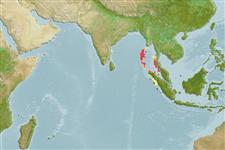>
Acanthuriformes (Surgeonfishes) >
Siganidae (Rabbitfishes)
Etymology: Siganus: Latin, siganus = a fish, rabbit fish; by the similarity of the nose (Ref. 45335).
Environment: milieu / climate zone / depth range / distribution range
Écologie
marin récifal; profondeur 2 - 30 m (Ref. 90102), usually 3 - 30 m (Ref. 27115). Tropical; 24°C - 28°C (Ref. 27115); 15°N - 0°N
Eastern Indian Ocean: Thailand, including the Similan Islands to Java, Indonesia.
Taille / Poids / Âge
Maturity: Lm ? range ? - ? cm
Max length : 24.0 cm SL mâle / non sexé; (Ref. 48637)
Description synthétique
Clés d'identification | Morphologie | Morphométrie
Épines dorsales (Total) : 13; Rayons mous dorsaux (Total) : 10; Épines anales: 7; Rayons mous anaux: 9; Vertèbres: 23. Ocular band dark chocolate brown to black; a broad white arc running from isthmus and thorax to bases of 2nd - 4th dorsal spines; posterior to white band, body brown or gray dorsally, whitish below. Spines stout, not very pungent and venomous. Preopercular angle 120°; strong overlapping scales cover cheeks, 8 or 9 rows deep below center of orbit; midline of thorax fully scaled. Opening of anterior nostril borne on a very short tube which is taller posteriorly.
Inhabits coral reefs and feeds on algae and small invertebrates. Adults occur in pairs, juveniles secretive in corals (Ref. 48637). Sometimes solitary (Ref. 90102). Maximum depth from Ref. 027115.
Life cycle and mating behavior
Maturité | Reproduction | Frai | Œufs | Fécondité | Larves
Woodland, D.J., 1990. Revision of the fish family Siganidae with descriptions of two new species and comments on distribution and biology. Indo-Pac. Fish. (19):136 p. (Ref. 1419)
Statut dans la liste rouge de l'IUCN (Ref. 130435: Version 2024-2)
Menace pour l'homme
Harmless
Utilisations par l'homme
Pêcheries: commercial; Aquarium: Commercial
Outils
Articles particuliers
Télécharger en XML
Sources Internet
Estimates based on models
Preferred temperature (Ref.
123201): 28.2 - 29.2, mean 28.7 °C (based on 36 cells).
Phylogenetic diversity index (Ref.
82804): PD
50 = 0.5000 [Uniqueness, from 0.5 = low to 2.0 = high].
Bayesian length-weight: a=0.01445 (0.00642 - 0.03257), b=3.07 (2.89 - 3.25), in cm total length, based on LWR estimates for this Genus-body shape (Ref.
93245).
Niveau trophique (Ref.
69278): 2.7 ±0.29 se; based on food items.
Résilience (Ref.
120179): Haut, temps minimum de doublement de population inférieur à 15 mois (Preliminary K or Fecundity.).
Fishing Vulnerability (Ref.
59153): Low vulnerability (19 of 100).
Nutrients (Ref.
124155): Calcium = 44.2 [21.2, 102.5] mg/100g; Iron = 0.696 [0.338, 1.657] mg/100g; Protein = 18.7 [17.2, 20.2] %; Omega3 = 0.116 [0.060, 0.231] g/100g; Selenium = 20.3 [8.1, 49.9] μg/100g; VitaminA = 39.9 [11.3, 136.8] μg/100g; Zinc = 1.3 [0.5, 2.8] mg/100g (wet weight);
